Gigabyte G5 Review
A gaming laptop with a great price
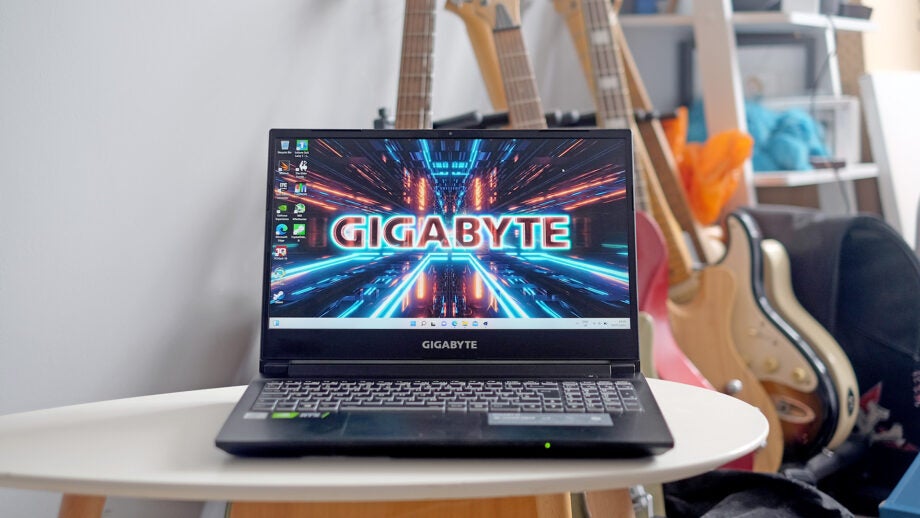

Verdict
The Gigabyte G5 remains a decent buy despite its older processor as a result of its good-quality screen and sensible pricing. Just don’t buy this gaming laptop expecting it to last too long off a charge.
Pros
- Surprisingly strong display
- Punchy 105W Nvidia RTX 3060 GPU
- Good value
Cons
- Uses an old, if powerful, CPU
- Poor battery life
- Keyboard gets a bit toasty in parts thanks to limited thermal isolation
Availability
- UKRRP: £950
Key Features
- Nvidia RTX 3060 GPUThis laptop has the Nvidia RTX 3060, a mid-level 105W version that works well at this native 1080p resolution.
- Rear-mounted connectorsThe Gigabytre G5 has a selection of rear connectors, including power and Ethernet, to make neat cable management much easier
Introduction
The Gigabyte G5 is an unusual gaming laptop; but you won’t be able to appreciate the ways in which it stands out from a look or touch. It’s pretty ordinary on the outside.
Gigabyte has deliberately used a 10th-generation Intel chip to bring down costs. It’s old now, and it was old the day this particular Gigabyte G5 model was released.
But this move actually makes sense in the wider context of this laptop. It means you can pick up an Nvidia RTX 3060 laptop for around £950; at the time of the review, the model could be found online for under £800.
And the feature of the laptop that persuaded me the Gigabyte G5 is a good deal? The screen. Sure, it’s only 1080p in resolution, but colour reproduction is great, brightness is above average and contrast is entirely sound.
There are a few compromises, but in my opinion these don’t draw away from the fact that this is a “bargain”.
Design
- Plain and sensible design
- Some rear-mounted connectors
- Mid-level 2.1kg weight
The Gigabyte G5 is a plain laptop. There are no metal panels, no RGB strips on the case, and none of the fan grilles are particularly ostentatious. Even the Gigabyte logo on the lid is the plainest you’ll find, because this laptop isn’t part of the higher-end Aero or Aorus series.
If you’re looking for gamer flair, you’ll see it only in the form of the keyboard. It has a distinctive font and an RGB backlight, although there’s just one zone. This means the entire keyboard has to be set to the same colour. You don’t have the entire rainbow to choose from, either; just 15 colours. But, honestly, these are the kind of shades most people would use anyway.
There’s no “white”, but if you pick the colour that appears a dark blue-grey, it’s basically off-white.
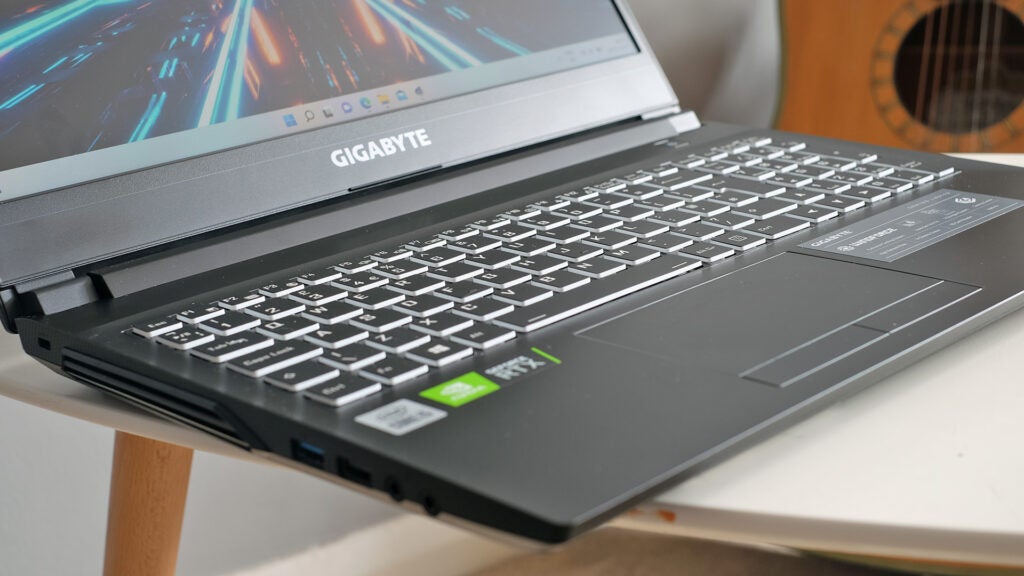
Assessing the appearance of a laptop will always come down to personal preference, but I prefer the look of the Gigabyte G5 to one of its key rivals, the Acer Nitro 5. The stripped-back style works, as does the combination of textures.
All the body panels are of a matte plastic. The lid and keyboard plate are ultra-smooth, while the bottom of the device sports a rougher texture. The section below the keyboard is prone to picking up greasy fingerprints quickly, but there’s a dense feel to the plastic that gives you more confidence in the Gigabyte’s G5 build quality.
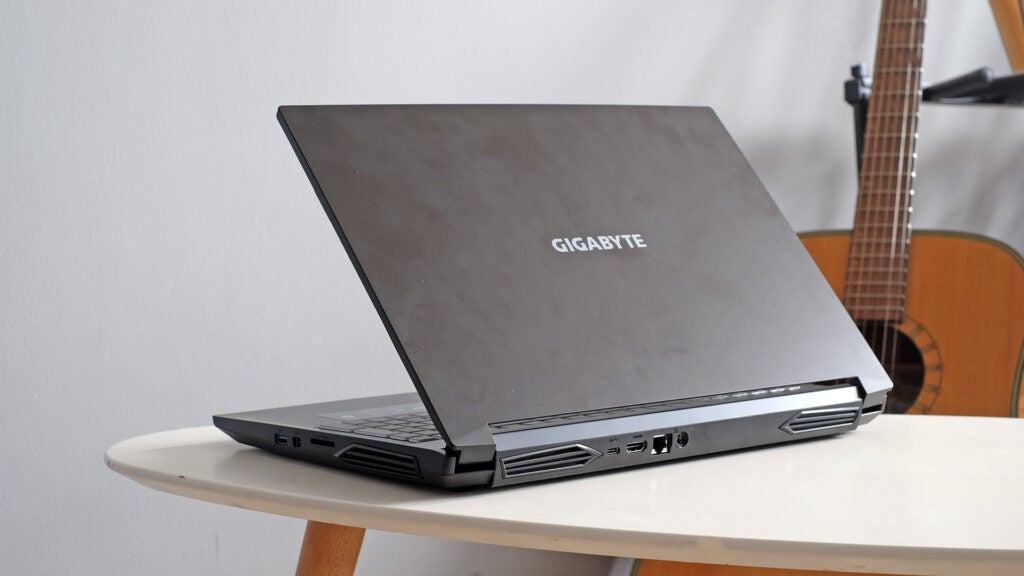
Other aspects of the build are solid for a “budget” gaming laptop. There’s a bit of flex on pressing down on the centre of the lid when the Gigabyte G5 is closed, but it’s minor – and what do you expect in a display with a plastic outer and a plastic-based display surface? The keyboard’s flexing is minimal, suggesting there’s a solid sub-frame below the top-most plastic surface.
The Gigabyte G5’s vital statistics are all middle of the road, too. It weighs 2.1kg, which is slightly lighter than some models, but not light enough to be notable. The device is 31.8mm thick at its chunkiest point, but the bottom corners are bevelled to take the edge off the substantial thickness.
There’s nothing too special going on here, but I do appreciate the way Gigabyte has positioned the G5’s connectors across the three sides of the laptop. Along the rear are the ports likely to be used when the laptop is setup more like a desktop PC: Ethernet, HDMI and a USB-C with DisplayPort. This is also where you’ll find the power connector. Clean cable management won’t be a problem with the G5.

A full-sized SD card slot sits on the right, just where I want it, alongside a USB-A and mini-DisplayPort. On the left is an additional USB-A 3.2, a USB 2.0 and two 3.5mm sockets. One is a combo mic/headphone jack, the other a dedicated mic input.
I’d prefer the USB 2.0 to be on the right – it’s the obvious one to use for a mouse – but, hey, it means left-handed people score a win for once.
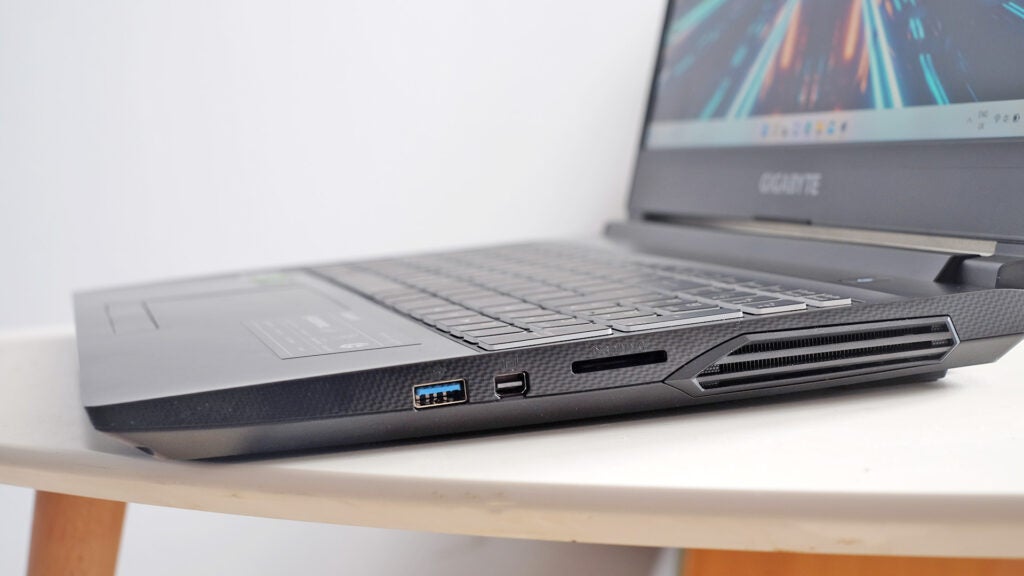

The keyboard itself offers good travel. Its keys are springier, less snappy, than the best; but the Gigabyte G5 compares well with other laptops of this class.
In cramming in a NUM pad, the spacing of the standard keys is squished slightly by a few millimetres. However, I don’t think it’s enough to spoil the keyboard’s comfort. I prefer gaming keyboards without NUM pads at 15.6 inches, but Gigabyte likely sees its inclusion as the safer bet.
The Gigabyte G5’s trackpad is very basic – a plastic pad with separate left and right buttons. There’s no clicker in the pad itself. This is a trackpad made with the knowledge a mouse is likely to be plugged into the G5 95% of the time.

The Gigabyte G5’s speakers are much like its trackpad: they’re present because a laptop has to have these things. Sound quality is poor, lacking any real representation of both the lowest and highest frequencies. Boxy, flat and timid, with an upper-mid range that tends to bunch up into ear-grating harshness with vocals in some music.
Still, budget gaming laptops don’t tend to feature good speakers anyway, so this isn’t a disaster. It’s largely what I expected – and, at most, marginally worse.
Display
- Good colour reproduction
- Decent brightness
- Respectable contrast
The Gigabyte G5 outer design offers no surprises, but the display is far better than I expected. This is a 15.6-inch Full HD “IPS-level” panel with a refresh rate of 144Hz.
Colour performance is excellent for a budget gaming laptop. It covers 100% of sRGB (114% by volume), 80.8% of DCI-P3 and 74.8% of Adobe RGB.
After fully expecting only partial coverage of sRGB, Gigabyte has come up with something special here. Sure, it isn’t a true wide gamut display, but it looks great in person.
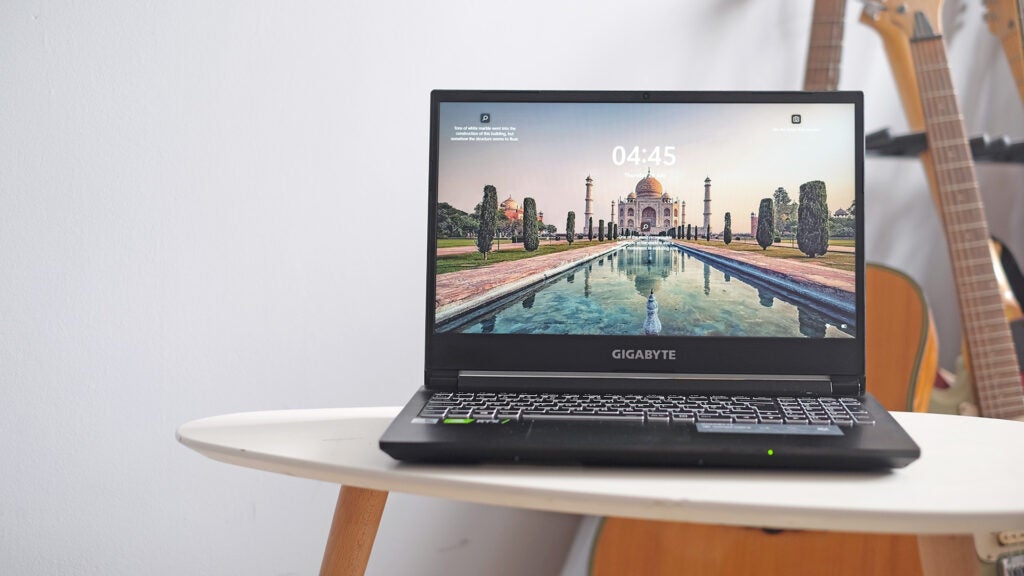
A contrast of 1100:1 is respectable, and maximum brightness of 334 nits is above average for an entry-level gaming laptop. The Gigabyte G5’s appeal hinges on this screen, a display better than that of the more expensive MSI Stealth 15M I looked at recently.
Motion handling is sound but not remarkable, as is to be expected of a panel of this style. Other aspects are normal gaming laptop fodder. You can’t push the screen back that far – just the standard laptop angle – and the screen surface is matte.
Performance
- Old but still punchy Intel Core i5 CPU
- Good Nvidia RTX 3060 with 105 max power
- Fans are quite noticeable
The Gigabyte G5 core specs mark it out as a laptop made entirely for gaming, because it uses the relatively old 10th Generation Intel Core i5-10500H CPU.
Don’t get me wrong, this processor is still easily powerful enough to handle video editing, Photoshop and other pro-level apps. However, it’s so thoroughly outpaced by the latest 12th-Gen CPUs, that those who will use CPU-dominant apps as often as they play games should consider something with a newer chipset. Gigabyte has a 12th-Gen version coming soon, but the below-RRP pricing of this review model may still make it a sound buy.
| Gigabyte G5 | Lenovo Legion 5i Pro (2022) | Acer Nitro 5 (2022) | |
| Processor | Intel Core i5-10500H | Intel Core i7-12700H | Intel Core i7-12700H |
| Geekbench 5 single/multi | 1162 / 11,098 | 1628 / 11,265 | 1745 / 10,043 |
| PCMark 10 | 5786 | 7152 | 7353 |
| GPU | Nvidia RTX 3060 | Nvidia RTX 3060 | Nvidia RTX 3070 Ti |
| 3DMark Time Spy | 8171 | 8448 | 9614 |
The Intel Core i5-10500H’s job isn’t to bottleneck the Nvidia RTX 3060 graphics card, and it’s highly unlikely to in more than 90% of games.
Gigabyte’s implementation of the RTX 3060 is also solid. Various specs of this card can draw from 60W to 130W of power, which is naturally going to have a dramatic impact on frame rates in games. The Gigabyte G5 coasts along at 95W in its default mode, and 105W in Performance mode.
This is better than the Acer Nitro 5, which taps out at 95W; but not as good as Lenovo Legion 5. That Lenovo offers full-whack 130W. If you can find a Legion selling at a similar price online, it’s probably a better bet.
In Performance mode the GPU ticks along at 86ºC, which is fine. However, the cooling system isn’t particularly refined. While it kicks out a good amount of hot air from each side of the laptop, the fans do have more of a noticeable higher-frequency component to their sound than the very best.

I don’t find these fans ridiculously loud in a pure decibel sense, even when maxed, but that treble component to the sound makes the noise more obvious. You may want to play with the fan curve, since the default makes it kick in loud and early. The Gigabyte G5’s keyboard also isn’t particularly well isolated from the heat generated.
After just a few minutes, the keys begin to warm up. And while the WASD area is less warm than the zone just to the left of the NUM pad, the thermal design here just doesn’t appear super optimised.
For example, the Lenovo Legion 5 has a fan platform that juts out behind the display, which likely helps to direct heat away from the most sensitive areas. In a money-to-performance calculation, the Gigabyte G5 is compelling. But like most budget gaming laptops, a few of the finer points are a little less than ideal.
Battery Life
- Poor battery life
- 48.9Wh battery capacity
Battery life clearly isn’t a priority of the Gigabyte G5. It has capacity of 48.9Wh – which would be fine in an Ultraportable, but it’s low for a gaming laptop.
After switching on Windows 11’s Battery Saver in the default Performance profile, the Gigabyte G5 lasted just 2hrs 44mins in PCMark 10’s Modern Office benchmark. This is designed to emulate bog-standard, office worker-style tasks.
It’s a pretty dreadful result. I re-ran the test using the laptop’s Power Saving mode, a Gigabyte feature accessible from within one of the pre-installed apps. The Gigabyte G5 lasted 3hrs 37mins. This is closer to the bog-standard gaming laptop battery life of 4-4.5 hours, but still poor.
However, this doesn’t have to be a deal-breaker if you approach the Gigabyte G5 with the right mindset. Most higher-power gaming PCs deliver fairly poor battery life, particularly those with Intel CPUs. And gaming on battery power is never a great experience. You lose a lot of the GPU’s power, and even with a huge capacity battery, 90 minutes is about the limit with a properly taxing title.
Latest deals
Should you buy it?
This is a good-value laptop with a fairly powerful graphics card and a commendable display for a lower-cost mode.
This Gigabyte G5 model has an old 10th-Gen Intel CPU. While it doesn’t affect gaming performance significantly in most cases, you may want to wait for the 12th-Gen version unless you find it selling at a good price.
Final Thoughts
The Gigabyte G5 is a bit of an oddball – a gaming laptop with a now fairly ancient 10th-Generation Intel CPU that, somehow, I feel able to recommend to plenty of folks.
Why? Three key factors are big hits: gaming performance, display quality and pricing. Having a slightly older CPU doesn’t matter that much when, at least for gaming, the GPU is going to provide the performance ceiling.
The screen is far more punchy than you might expect, offering excellent colour for a laptop of this grade and above-average brightness.
Sure, the speakers are rubbish, battery life is poor and the design may be a bit bland for RGB nuts. But the only big problem here is that this juncture you can often find older, categorically superior gaming laptops on sale at just as compelling prices. It’s a function of the Nvidia RTX 3060 having been around for quite a while at this point.
How we test
Every laptop we review goes through a series of uniform checks designed to gauge key things including build quality, performance, screen quality and battery life.
These include formal synthetic benchmarks and scripted tests, plus a series of real-world checks, such as how well it runs the most frequently used apps.
We also make sure to use every laptop we review as our primary device to ensure our review is as accurate as possible.
Used the laptop for at least a week.
Used Geekbench 5 and 3DMark to test performance.
Used a colorimeter to test the display.
Used PCMark 10 to test the battery life.
FAQs
The RTX 3060 graphics card has hardware-level support for ray tracing effects.
There’s no Thunderbolt port here, just a slower USB-C.
The display supports a 144Hz refresh rate.
Trusted Reviews test data
Full specs
Sustainability
TrustedReviews’ holds the fact that global warming is not a myth as a core value and will continuously endeavor to help protect our planet from harm in its business practices.
As part of this mission, whenever we review a product we send the company a series of questions to help us gauge and make transparent the impact the device has on the environment.
We currently haven’t received answers to the questions on this product, but will update this page the moment we do. You can see a detailed breakdown of the questions we ask and why in our sustainability info page.


